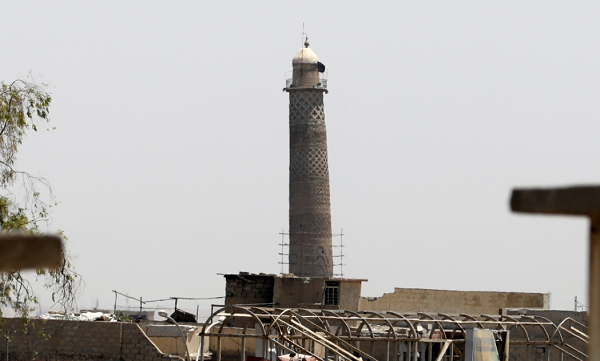
In what is being considered the Islamic State's declaration of defeat, ISIS blew up the Great al-Nuri Mosque in Mosul on Wednesday, depriving the world of yet another historical monument. The iconic leaning minaret, which had been standing in the Iraqi city for nearly 850 years, came crumbling down Wednesday following an exchange between the jihadist millitant group and a U.S.-led military coalition called Combined Joint Task Force Operation Inherent Resolve.
Initially, ISIS blamed a U.S. airstrike for the destruction of the mosque. However, Major General Joseph Martin, who heads the task force in Iraq and Syria, later said in a statement that the "responsibility of this devastation is laid firmly at the doorstep of ISIS."
"As our Iraqi Security Force partners closed in on the al-Nuri mosque, ISIS destroyed one of Mosul and Iraq's great treasures," he said. "This is a crime against the people of Mosul and all of Iraq, and is an example of why this brutal organization must be annihilated."
It was at the steps of the al-Nuri where ISIS leader Abu Bakr al-Baghdadi declared the caliphate after Sunnis took over Mosul in 2014. Since then, the black ISIS flag has flown atop the 150-foot landmark, commonly referred to as "the hunchback" by Iraqi locals.
Al-Nuri is just one of many sites of historical and cultural significance that jihadists have ruined since their rise to power.
Below is a list of ancient landmarks that have been destroyed by ISIS.
Iraq’s Historic St. Elijah’s Monastery Has Been ‘Pulverized’ by #ISIS: AP https://t.co/F3TN3HyXPb @Sky1876ent #News pic.twitter.com/mh6AyWjhuw
— SKY 1876 MARKETING (@Sky1876Online) February 10, 2016
1. The monastery of St. Elijah: The Mosul monastery was destroyed by ISIS in 2014. The sanctuary dated back to the 11th century and was considered one of the most historical Christian sites in Iraq. Satellite photographs of St. Elijah's Monastery released in 2016 showed a number of rooms at the complex had been ruined after ISIS gained control of Iraqi forces in the area.
2. Palmyra in Syria: In 2015, ISIS released a video documenting the explosion at the Temple of Baalshamin, which was considered one of Palmyra's best-preserved ancient ruins. Dating back to the third century, the columns and temples in Palmyra, located in the desert east of Damascus, were once part of a thriving city during Queen Zenobia's rule before it was taken over by the Roman Empire in 273 A.D.
Horrific destruction turning #Nimrud into rubble.Can't believe we lost this great #Assyrian city forever. #ISIS @CNN https://t.co/Zyqa8A1lGY pic.twitter.com/XhxcFaWXlM
— Basileus Zeno (@BasileusZeno) February 28, 2017
3. Nimrud: Founded some 3,300 years ago, Nimrud was the first documented Assyrian capital, rediscovered by British excavators and archaeologists in the 1840s. The compound, covering 890 acres of land, was home to a 2,900-year-old pyramid temple as well as the tombs of kings and several religious monuments. Photos of the area released in 2016 showed parts of Nimrud had been bulldozed by ISIS after it gained control of the area in 2014.
French archaeologist #Félix Thomas at #Assyrian Gateway in #Nineveh, #Assyria, Year 1853 pic.twitter.com/R8B5zVdF1o
— ASSYRIA NEWS (@Assyrianews1) June 3, 2017
4. Nineveh: A part of ancient Assyria, the vast city of Nineveh was established sometime between 900 and 600 B.C. Although a portion of Mosul was built over the ruins of Nineveh, the landscape was still home to various historic sculptures that were housed in the Mosul Museum. Members of ISIS were seen on video destroying the museum and several of the artifacts dating back to the Nineveh era, including half-animal guardian statues called lamassus that once stood at the city's famous Nirgal Gate.
Iraq’s Hatra retaken from IS militants, but still vulnerable. By Adnan Abu Zeed https://t.co/xZycmpUHxe pic.twitter.com/e3UgtE68cO
— Iraqi Economists (@iraqieconomists) June 17, 2017
5. Hatra: Named a UNESCO World Heritage site in 1985, Hatra dated back to the third century B.C. The city, where buildings and temples echoed Greek- and Roman-influenced architecture, was once a known trading center along the Silk Road. ISIS took over the area in 2014 and a year later released videos of its soldiers destroying artifacts on Hatra grounds with sledgehammers and automatic weapons.
Uncommon Knowledge
Newsweek is committed to challenging conventional wisdom and finding connections in the search for common ground.
Newsweek is committed to challenging conventional wisdom and finding connections in the search for common ground.
About the writer
Michigan native, Janice Williams is a graduate of Oakland University where she studied journalism and communication. Upon relocating to New ... Read more
To read how Newsweek uses AI as a newsroom tool, Click here.








